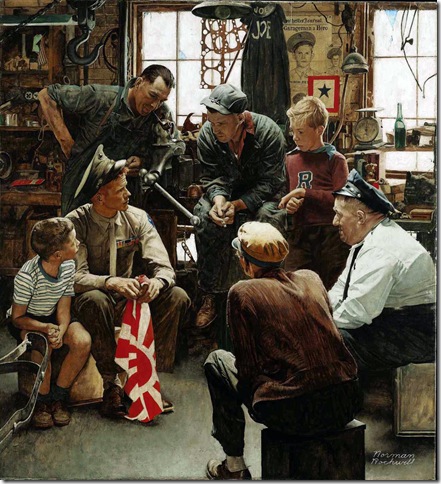I must confess that I generally care little for the paintings of Norman Rockwell, but I care plenty for the masterful analysis of art. Nick Provenzo's illuminating discussion of this Rockwell classic, of what seems at first glance just a simple naturalistic painting, is a signal lesson in how to begin analysing a figurative painting -- or any real artwork. It's first rate.
The key is to understand that nothing in art is accidental -- the artist has chosen everything with some purpose in mind. Everything is intentional; it's the viewer's task to answer the why.

10 comments:
To start with I can see a card with a star in the background. They were given to american families that had lost a member in combat to place in their windows. So this group represented here has is welcoming a son home but has another that will never come back.
I'm not sure about the star thing (although I might be completely off the mark here, as my source is somewhat dubious).
I recall from "Saving Private Ryan" that Ryan's mother had four stars in her home window when the priest showed up to give her the bad news that three of her sons had been killed. There is no dialogue in the scene, so no help there. But the inference is that the stars represent the number of family memebers sent away to the war - not the casualties.
Now, knowing that Rockwell was something of a 'feelgood' artist, perhaps the significance of the star (given that it is now not being displayed in the front window, but is out-of-sight in the garage, is that this family sent one son to war and he returned safely - therefore a happy ending.
Ah, not quite, Sean, but on the right track -- at least, Mr Provenzo suggests something slightly different. Did you see the link to his analysis?
The star represents a serving member of the household. A GOLD star is for a death.
http://www.atlasgeo.net/fotw/flags/us%5esvc.html
I am reminded of 2 real photos I saw recently. The first taken at Trentham of a USMC company of maybe 200 odd men. All fit, well fed and looking staunch with my host, their former company commander, in the front row. The second photo showed maybe 20 men with a grim and lean hard look. I asked 'Were these your officers and NCO's?" He replied that they were the survivors of the first photograph after 3 years in the Pacific theater.
Gaudalcanal, Tarawa and Iwo had seen the rest off as casualties. I wish every mindless anti-American prat could see those two pictures. My host died an old man,a short time back. I don't think in his wildest dreams he expected to return to the USA alive.
The blue star was for someone that was in the service, in this case the Homecoming Marine. A gold star would be if the that person was killed. I believe the people in the garage put up the little banner with the blue star for the local garage man who went to war and returned a hero. Read the newspaper headlines and look at the photos near the blue star in the picture,
S/F
I think the first two ribbons on the marine's chest are the silver star and purple heart, but you'll probably need a better image to make this out.
The Marine served with the 1st Marine Division as his shoulder patch would indicate. The ribbons indicate (L-R/U-D) he received the Silver Star for significant heroic action against the enemy, the Purple Heart for wounds received during combat, the Presidential Unit Citation, the highest award a unit can receive for distinguished service during combat, the China Service Medal, the WW II Asiatic-Pacific Campaign Medal with three bronze stars representing four separate engagements with the enemy, and the Navy Occupation Service Medal. This Marine, as a member of the 1st Marine Division, participated and survived some of the most vicious fighting in the Pacific to include Guadalcanal, Cape Gloucester, Peleliu, and Okinawa. Immediately after Japan's surrender, the Division was sent to China for occupation duty until 1947. His "Old Breed" eyes indicate he has seen it all.
Semper Fidelis
The blue star on the wall represents someone close to you or in the immediate family is in active service. If there was a gold star, the serviceman was killed in action.
The star answer above is on point for WW2
Post a Comment